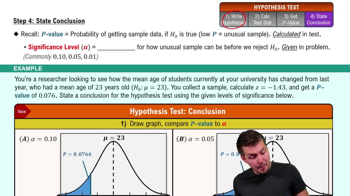In Exercises 11 and 12, find the P-value for the hypothesis test with the standardized test statistic z. Decide whether to reject H0 for the level of significance α.
Left-tailed test, z = -0.94, α = 0.05
 Verified step by step guidance
Verified step by step guidance Verified video answer for a similar problem:
Verified video answer for a similar problem:



 5:12m
5:12mMaster Intro to Hypothesis Testing with a bite sized video explanation from Patrick
Start learning